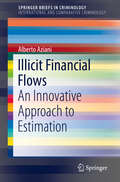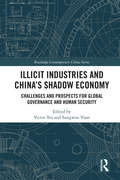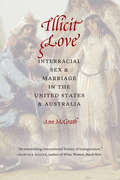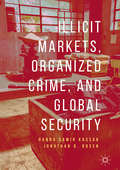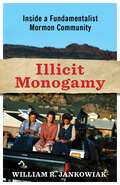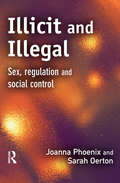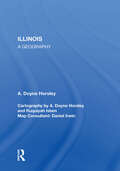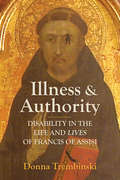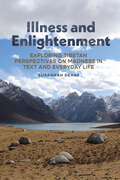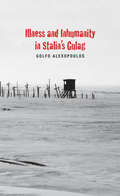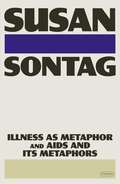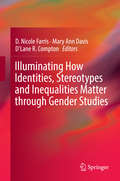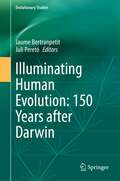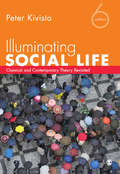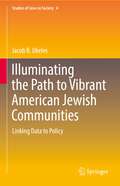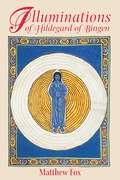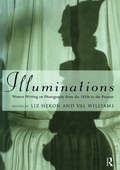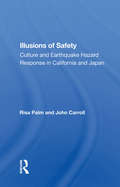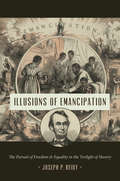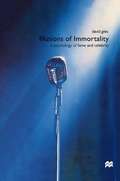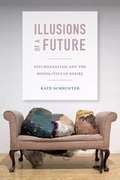- Table View
- List View
Illicit Financial Flows: An Innovative Approach to Estimation (SpringerBriefs in Criminology)
by Alberto AzianiIllicit Financial Flows (IFFs) have received increased attention in light of international corruption scandals, high-profile leaks about extensive tax abuse schemes, and the continued fight against terrorism financing and organized crime. Reducing IFFs is now a key target of the UN Sustainable Development Goals, renewing debates about both how to operationally define IFF and the methodologies that are used to estimate their extent.This book addresses these key issues, by investigating and schematizing the concept of illicit financial flows and critically evaluating the current models used to estimate them. It book proposes an original flow-network approach through which to produce longitudinal and country-specific estimates of IFFs and the gross value added related to transnational trafficking. It advocates for a reformulation of the current definition of IFFs to one that is more specific and operational, allowing scholars and policy-makers to better clarify the relationship between IFFs, the sources of capital and the channels that are used to move capital abroad. This brief will be an indispensable guide for students of criminology and organized crime, and for the researchers and practitioners working to understand and combat these crimes.
Illicit Industries and China’s Shadow Economy: Challenges and Prospects for Global Governance and Human Security (Routledge Contemporary China Series)
by Victor Teo Sungwon YoonThis book considers a wide range of illicit industries in China, exploring what drives such activities, why consumers tolerate them to differing degrees, how attempts to regulate them are implemented and how such regulation is resisted. Industries considered include human smuggling, human organs trade, illicit pharmaceuticals, smuggling of animal parts, illegal logging and trade of woods, food safety and shadow banking. Throughout, the book describes how the shadow economy works, analyses the degree to which illicit activities are regarded as criminal and highlights the importance of the shadow economy for certain regions of China and certain sections of Chinese society. In doing so, it reveals the challenges of human security posed by these industries not only for China, but also for the global community, and considers a robust governance mechanism at both national and global levels to address these challenges. Overall, the book provides a very rich picture of a key aspect of China’s contemporary economy which is difficult to research.
Illicit Love: Interracial Sex and Marriage in the United States and Australia (Borderlands and Transcultural Studies)
by Ann McGrathIllicit Love is a history of love, sex, and marriage between Indigenous peoples and settler citizens at the heart of two settler colonial nations, the United States and Australia. Award-winning historian Ann McGrath illuminates interracial relationships from the late eighteenth to the early twentieth century through stories of romance, courtship, and marriage between Indigenous peoples and colonizers in times of nation formation.The romantic relationships of well-known and ordinary interracial couples provide the backdrop against which McGrath discloses the “marital middle ground” that emerged as a primary threat to European colonial and racial supremacy in the Atlantic and Pacific Worlds from the Age of Revolution to the Progressive Era. These relationships include the controversial courtship between white, Connecticut-born Harriett Gold and southern Cherokee Elias Boudinot; the Australian missionary Ernest Gribble and his efforts to socially segregate the settler and aboriginal population, only to be overcome by his romantic impulses for an aboriginal woman, Jeannie; the irony of Cherokee leader John Ross’s marriage to a white woman, Mary Brian Stapler, despite his opposition to interracial marriages in the Cherokee Nation; and the efforts among ordinary people in the imperial borderlands of both the United States and Australia to circumvent laws barring interracial love, sex, and marriage.Illicit Love reveals how marriage itself was used by disparate parties for both empowerment and disempowerment and came to embody the contradictions of imperialism. A tour de force of settler colonial history, McGrath’s study demonstrates vividly how interracial relationships between Indigenous and colonizing peoples were more frequent and threatening to nation-states in the Atlantic and Pacific worlds than historians have previously acknowledged.
Illicit Markets, Organized Crime, and Global Security
by Jonathan D. Rosen Hanna Samir KassabThis book explains the existence of illicit markets throughout human history and provides recommendations to governments. Organized criminal networks increased in strength after the enforcement of prohibition, eventually challenging the authority of the state and its institutions through corruption and violence. Criminal networks now organize under cyber-infrastructure, what we call the Deep or Dark Web. The authors analyze how illicit markets come together, issues of destabilization and international security, the effect of legitimate enterprises crowded out of developing countries, and ultimately, illicit markets' cost to human life.
Illicit Medicines in the Global South: Public Health Access and Pharmaceutical Regulation (Routledge Global Health Series)
by Mathieu QuetThis book investigates pharmaceutical regulation and the public health issue of fake or illicit medicines in developing countries. The book analyses the evolution of pharmaceutical capitalism, showing how the entanglement of market and health interests has come to shape global regulation. Drawing on extensive fieldwork in India, Kenya and Europe, it demonstrates how large pharmaceutical companies have used the fight against fake medicines to serve their strategic interests and protect their monopolies, sometimes to the detriment of access to medicines in developing countries. The book investigates how the contemporary dynamics of pharmaceutical power in global markets have gone on to shape societies locally, resulting in more security-oriented policies. These processes highlight the key consequences of contemporary "logistical regimes" for access to health. Providing important insights on how the flows of commodities, persons, and knowledge shape contemporary access to medicines in the developing countries, this book will be of considerable interest to policy makers and regulators, and to scholars and students across sociology, science and technology studies, global health, and development studies.
Illicit Monogamy: Inside a Fundamentalist Mormon Community
by William JankowiakAngel Park is a Mormon fundamentalist polygamous community where plural marriages between one man and multiple women are common. In contrast to mainstream America’s idealization of the nuclear family and romantic love, its residents esteem notions of harmonious familial love, a spiritual bond that unites all family members. In their view, polygyny is not only righteous and sanctified—it is also conducive to communal life and social stability.Based on many years of in-depth ethnographic research in Angel Park, this book explores daily life in a polygamous community. William R. Jankowiak considers the plural family from the points of view of husbands, wives, and children, giving a balanced account of its complications and conflicts. He finds that people in polygynous marriages, especially cowives, experience an ongoing struggle to balance the longing for romantic intimacy with the obligation to support the larger family. They feel tension between deeply held religious convictions and the desire for emotional exclusivity, which can threaten the stability and harmony of the polygamous family. Men and women often form exclusive romantic pairs within plural marriages, which are tolerated if not openly acknowledged, showing the limits of the community’s beliefs. Jankowiak also challenges stereotypes of polygamous families as bastions of patriarchal power, showing the weight that interpersonal and social expectations place on men.Offering an unparalleled look at the complexity of a polygamous religious community, Illicit Monogamy also helps us reconsider relationships, love, and family dynamics across cultures and settings.
Illicit and Illegal
by Joanna Phoenix Sarah OertonThis book is about the surprisingly neglected area of the regulation of sex. It describes and discusses the ways in which various sexual activities are controlled, regulated and made illegal and/or deviant and illicit. Its primary focus is upon the multiple and complex social controls (laws, statutory regulations, professional/occupational codes, normative frameworks) constructing, constituting and shaping how we 'do' sex, and deals with sex that is both illicit (deviant, illegal) and illegal (criminal, offending). The book challenges the idea that early twenty-first century Britain is increasingly sexually 'liberated' by suggesting that this very 'openness' provides the conditions in which all sexual activities have become increasingly subject to regulation and control. By examining the policies and laws about various sexually activities, and the social conditions underpinning them, alongside existing research and theoretical literature the authors have provided an accessible text on the sociology of sex.
Illinois: A Geography
by A. Doyne HorsleyHorsley focuses on the contrasting environments within the state of Illinois and on the interactions of the inhabitants with their surroundings. He uses a standard Progressing from the physical and historical factors, through economic activities, concluding with chapters on Chicago and its suburbs. The text includes an urban-rural traverse across the state and a series of maps on presidential voting records by counties, 1960 to 1984.
Illiterate America
by Jonathan Kozol"Kozol. . . has assembled facts, rebuttals, and proposals-in an emotionally potent, ethically charged package. "-Kirkus.
Illness and Authority: Disability in the Life and Lives of Francis of Assisi
by Donna TrembinskiIllness and Authority examines the lived experience and early stories about St. Francis of Assisi through the lens of disability studies. This new approach re-centres Francis’s illnesses and infirmities and highlights how they became barriers to wielding traditional modes of masculine authority within both the Franciscan Order he founded and the church hierarchy. So concerned were members of the Franciscan leadership that the future saint was compelled to seek out medical treatment and spent the last two years of his life in the nearly constant care of doctors. Unlike other studies of Francis’s ailments, Illness and Authority focuses on the impact of his illnesses on his autonomy and secular power, rather than his spiritual authority. From downplaying the comfort Francis received from music to disappearing doctors in the narratives of his life, early biographers worked to minimize the realities of his infirmities. When they could not do so, they turned the saint’s experiences into teachable moments that demonstrated his saintly and steadfast devotion and his trust in God. Illness and Authority explores the struggles that early authors of Francis’s vitae experienced as they tried to make sense of a saint whose life did not fit the traditional rhythms of a founder-saint.
Illness and Culture in the Postmodern Age
by David B. MorrisWe become ill in ways our parents and grandparents did not, with diseases unheard of and treatments undreamed of by them. Illness has changed in the postmodern era—roughly the period since World War II—as dramatically as technology, transportation, and the texture of everyday life. Exploring these changes, David B. Morris tells the fascinating story, or stories, of what goes into making the postmodern experience of illness different, perhaps unique. Even as he decries the overuse and misuse of the term "postmodern," Morris shows how brightly ideas of illness, health, and postmodernism illuminate one another in late-twentieth-century culture.Modern medicine traditionally separates disease—an objectively verified disorder—from illness—a patient's subjective experience. Postmodern medicine, Morris says, can make no such clean distinction; instead, it demands a biocultural model, situating illness at the crossroads of biology and culture. Maladies such as chronic fatigue syndrome and post-traumatic stress disorder signal our awareness that there are biocultural ways of being sick.The biocultural vision of illness not only blurs old boundaries but also offers a new and infinitely promising arena for investigating both biology and culture. In many ways Illness and Culture in the Postmodern Age leads us to understand our experience of the world differently.
Illness and Enlightenment: Exploring Tibetan Perspectives on Madness in Text and Everyday Life
by Susannah DeaneTibetan understandings of nyoné — ‘madness’— encompass a broad range of concepts. Perspectives on the causation and treatment of madness as an illness are informed by Tantric and medical understandings of mind-body structure and (dys)functioning, as well as people’s relationships with non-human entities. In addition, ‘madness’ may be seen as a sign of enlightenment in the case of some Tantric practitioners. Based on ethnographic fieldwork in the Tibetan region of Amdo in northwest China, as well as examination of Tibetan medical and religious texts, Illness and Enlightenment explores the multi-faceted concept of nyoné through key Tibetan concepts of wind, heart, and mind, as well as human-spirit relationships.
Illness and Inhumanity in Stalin's Gulag
by Golfo AlexopoulosA new and chilling study of lethal human exploitation in the Soviet forced labor camps, one of the pillars of Stalinist terror In a shocking new study of life and death in Stalin’s Gulag, historian Golfo Alexopoulos suggests that Soviet forced labor camps were driven by brutal exploitation and often administered as death camps. The first study to examine the Gulag penal system through the lens of health, medicine, and human exploitation, this extraordinary work draws from previously inaccessible archives to offer a chilling new view of one of the pillars of Stalinist terror.
Illness as Metaphor and AIDS and Its Metaphors (Penguin Modern Classics Ser.)
by Susan SontagSusan Sontag's celebrated essays on cancer and AIDS now available in one volume. In 1978, Sontag wrote Illness as Metaphor, a classic work described by Newsweek as "one of the most liberating books of its time." A cancer patient herself when she was writing the book, Sontag shows how the metaphors and myths surrounding certain illnesses, especially cancer, add greatly to the suffering of patients and often inhibit them from seeking proper treatment. By demystifying the fantasies surrounding cancer, Sontag shows cancer for what it is--just a disease. Cancer, she argues, is not a curse, not a punishment, certainly not an embarrassment and, it is highly curable, if good treatment is followed. Almost a decade later, with the outbreak of a new, stigmatized disease replete with mystifications and punitive metaphors, Sontag wrote a sequel to Illness as Metaphor, extending the argument of the earlier book to the AIDS pandemic. These two essays now published together, Illness as Metaphor and AIDS and Its Metaphors, have been translated into many languages and continue to have an enormous influence on the thinking of medical professionals and, above all, on the lives of many thousands of patients and caregivers.
Illuminating How Identities, Stereotypes and Inequalities Matter through Gender Studies
by D'Lane R. Compton D. Nicole Farris Mary Ann DavisThis collection highlights and extends contemporary women's and gender studies by presenting theoretical analyses and innovative research conceptualizations, applications and methodologies via a diverse variety of popular-in-the-classroom topics, such as changing masculinities; comedic/dramatic portrayals of ethnicity and discrimination; stigma and differences within mainstream media gender stereotypes; intersections of gendered and sexual identities in social media and fundamental institutions. These topics emphasize relevant issues and nuances within popular culture, identities and perceptions and social problems and illustrate the breadth of gender studies and its applications, while the diverse methodologies like historical comparisons; ethnographic, demographic and statistical analyses, demonstrate its epistemology. Each chapter remains solidly founded in gender theory while making significant innovative contributions to the overall field.
Illuminating Human Evolution: 150 Years after Darwin (Evolutionary Studies)
by Juli Peretó Jaume BertranpetitThis book presents a series of perspectives showing the current knowledge about human evolution. On the occasion of the 150th anniversary of Darwin's book, The Descent of Man, and Selection in Relation to Sex, in which he explicitly addresses the natural origin of the human species, this collective work reviews current and diverse aspects of human evolution: from psychology, linguistics, genomics, paleontology, artistic expression or sexual selection. It also offers a historical, social and ideological context of what is often considered to be Darwin's second great work after The Origin of Species.Although current research is concentrated largely on fossils and genomes, this book also deals with the main points Darwin centered his attention on; comparative morphology and psychology, and sexual selection. It also covers other new aspects, such as the origin of art, social structure and social learning. With contributions from leading experts in their respective fields, the book guides readers to the study of the social context of Darwin and his time, and the state of the art of studies on human evolution and sexual selection, considering all aspects that Darwin examined, including those that emerged later and now are important disciplines in our understanding of our own evolution.The English translation of parts of this book from its Spanish original manuscript was done with the help of artificial intelligence (machine translation by the service DeepL.com). A subsequent human revision was done primarily in terms of content.
Illuminating Social Life: Classical and Contemporary Theory Revisited
by Peter KivistoThe sixth edition of Peter Kivisto's popular anthology, Illuminating Social Life, continues to demonstrate to students how social theories can help them make sense of the swirling events and perplexing phenomena that they encounter in their daily lives. A perfect complement for sociological theory courses, this updated edition includes 13 original essays by leading scholars in the field that help students better understand and appreciate the relevance of social theory. Once again, Peter Kivisto's collection illuminates the connection between sociological theory and the realities that students are faced with every day —from the Internet, alcohol use, and body building to shopping malls, the working world, and fast-food restaurants
Illuminating Social Life: Classical and Contemporary Theory Revisited (3rd Edition)
by Peter KivistoHow classical and contemporary social theories are used to shed light on the internet, fast food restaurants, shopping malls, and other new topics.
Illuminating the Path to Vibrant American Jewish Communities: Linking Data to Policy (Studies of Jews in Society #4)
by Jacob B. UkelesThis book argues that the way to ensure that American Jewish life flourishes is to create vibrant local communities and that the ability to thrive will be won or lost in the trenches of each locality. For every generalization about the Jews of America, one can say, “maybe, but it depends where.” In the United States, Jewish life is up close and personal where local variations on national themes make a huge difference. The author presents case studies using in-depth analysis of data from nine Jewish community studies to illuminate eleven critical American Jewish policy issues. The analysis is used to formulate a range of policy options for different types of communities. This book is for anyone who cares about the future of American Jewry. It should be of particular interest to the lay leaders and professionals who play a role in Jewish nonprofits. It is also of great interest to researchers and students of Jewish studies and Jewish communal service.
Illuminations of Hildegard of Bingen
by Matthew FoxAn introduction to the life and work of Hildegard. • Reveals the life and teachings of one of the greatest female artists and intellectuals of the Western Mystical Tradition. • Contains 24 full-color illustrations by Hildegard of Bingen. • Includes commentary by Matthew Fox, author of Original Blessing (250,000 sold). Hildegard of Bingen (1098-1179) was an extraordinary woman living in the Rhineland valley during most of the twelfth century. Besides being the abbess of a large and influential Benedictine abbey, she was a prominent preacher, healer, scientist, and artist. She also was a composer and theologian, writing nine books on theology, medicine, science, and physiology, as well as 70 poems and an opera. At the age of 42, she began to have visions; these were captured as 36 illuminations--24 of which are recorded in this book along with her commentaries on them. She also wrote a text describing these visions entitled Scivias (Know the Ways), now published as Hildegard of Bingen's Mystical Visions. Author Matthew Fox has stated, "If Hildegard had been a man, she would be well known as one of the greatest artists and intellectuals the world has ever seen." It is a credit to the power of the women's movement and our times that this towering genius of Western thought is being rediscovered in her full grandeur and autonomy. Virtually unknown for more than 800 years in Western history, Hildegard was featured as one of the women in Judy Chicago's Dinner Party in the early 1980s and published for the first time in English by Bear & Company in 1982. In addition to her mystical teachings, Hildegard's music has been performed and recorded for a new and growing audience.
Illuminations: Women Writing on Photography from the 1850's to the Present
by Liz HeronThis selection of women's writings on photography proposes a new and different history, demonstrating the ways in which women's perspectives have advanced photographic criticism over 150 years, focusing it more deeply and, with the advent of feminist approaches, increasingly challenging its orthodoxies. Included in the book are Rosalind Krauss, Ingrid Sischy, Vicki Goldberg and Carol Squiers.
Illusions Of Safety: Culture And Earthquake Hazard Response In California And Japan
by Risa PalmThis book is based upon work supported by the National Science Foundation under Grant Nos. CMS-9542154 and CMS-9316749. Any opinions, findings, and conclusions or recommendations expressed in this material are those of the authors and do not necessarily reflect the views of the National Science Foundation. We wish to acknowledge the collaboration of Professor Shinobu Kitayama of Kyoto University in sharing in the design of the study. Kitayama developed the application of the concepts drawn from "cultural psychology" to the specific research topic of earthquake hazards response, conducted focus groups in Yaizu and Shimizu that resulted in the development of a cross-cultural questionnaire design, was in charge of the survey execution in Japan, and participated in every stage of the analysis of survey results. Professor Mayumi Karasawa of Shirayuri College in Tokyo coordinated the administration of the survey research in Japan. In Japan, an undergraduate, Takahiko Masuda of Kyoto University, managed the data analysis and coordination with the Oregon team. In Oregon, two graduate students in geography participated in the study design and execution: Tom Kochevar, and Daphne Minton.
Illusions of Emancipation: The Pursuit of Freedom and Equality in the Twilight of Slavery (Littlefield History of the Civil War Era)
by Joseph P. ReidyAs students of the Civil War have long known, emancipation was not merely a product of Lincoln's proclamation or of Confederate defeat in April 1865. It was a process that required more than legal or military action. With enslaved people fully engaged as actors, emancipation necessitated a fundamental reordering of a way of life whose implications stretched well beyond the former slave states. Slavery did not die quietly or quickly, nor did freedom fulfill every dream of the enslaved or their allies. The process unfolded unevenly.In this sweeping reappraisal of slavery's end during the Civil War era, Joseph P. Reidy employs the lenses of time, space, and individuals' sense of personal and social belonging to understand how participants and witnesses coped with drastic change, its erratic pace, and its unforeseeable consequences. Emancipation disrupted everyday habits, causing sensations of disorientation that sometimes intensified the experience of reality and sometimes muddled it. While these illusions of emancipation often mixed disappointment with hope, through periods of even intense frustration they sustained the promise that the struggle for freedom would result in victory.
Illusions of Immortality: A Psychology Of Fame And Celebrity
by David GilesWhat drives people to crave fame and celebrity? How does fame affect people psychologically? These issues are frequently discussed by the media but up till now psychologists have shied away from an academic away from an academic investigation of the phenomenon of fame. In this lively, eclectic book David Giles examines fame and celebrity from a variety of perspectives. He argues that fame should be seen as a process rather than a state of being, and that `celebrity' has largely emerged through the technological developments of the last 150 years. Part of our problem in dealing with celebrities, and the problem celebrities have dealing with the public, is that the social conditions produced by the explosion in mass communications have irrevocably altered the way we live. However we know little about many of the phenomena these conditions have produced - such as the `parasocial interaction' between television viewers and media characters, and the quasi-religious activity of `fans'. Perhaps the biggest single dilemma for celebrities is the fact that the vehicle that creates fame for them - the media - is also their tormentor. To address these questions, David Giles draws on research from psychology, sociology, media and communications studies, history and anthropology - as well as his own experiences as a music journalist in the 1980s. He argues that the history of fame is inextricably linked to the emergence of the individual self as a central theme of Western culture, and considers how the desire for authenticity, as well as individual privacy, have created anxieties for celebrities which are best understood in their historical and cultural context.
Illusions of a Future: Psychoanalysis and the Biopolitics of Desire
by Kate SchechterA pioneering ethnography of psychoanalysis, Illusions of a Future explores the political economy of private therapeutic labor within industrialized medicine. Focusing on psychoanalysis in Chicago, a historically important location in the development and institutionalization of psychoanalysis in the United States, Kate Schechter examines the nexus of theory, practice, and institutional form in the original instituting of psychoanalysis, its normalization, and now its "crisis." She describes how contemporary analysts struggle to maintain conceptions of themselves as capable of deciding what psychoanalysis is and how to regulate it in order to prevail over market demands for the efficiency and standardization of mental health treatments.In the process, Schechter shows how deeply imbricated the analyst-patient relationship is in this effort. Since the mid-twentieth century, the "real" relationship between analyst and patient is no longer the unremarked background of analysis but its very site. Psychoanalysts seek to validate the centrality of this relationship with theory and, through codified "standards," to claim it as a privileged technique. It has become the means by which psychoanalysts, in seeking to protect their disciplinary autonomy, have unwittingly bound themselves to a neoliberal discourse of regulation.
